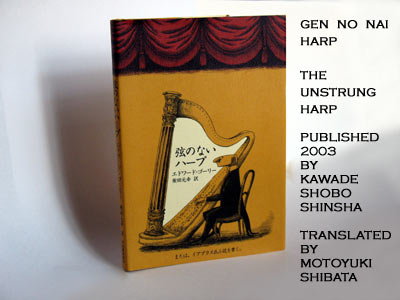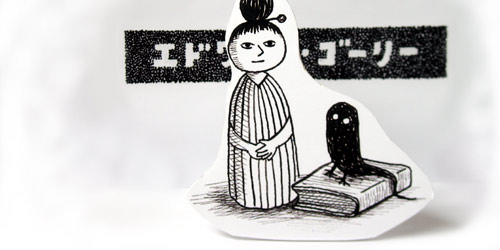TRANSLATION OR TRANSFORMATION
pg
1
2
3
4
5
6
7
8
9
 INTRODUCTION
INTRODUCTION

A WorldCat view of Prof. Motoyuki Shibata's works
Looking for Gorey in the Land of the Rising Sun? Try these companies. Most display Japanese only*
Kawade Shobo
Rakuten
Amazon
Kinokuniya

* and if your computer isn't set up for Asian languages, you may see a lot of question marks
|
 |
There are other key differences in syntax between English and Japanese, taken together with what we’ve seen, makes a straightforward translation unusable. So instead of just hoping to hit the mark by rewriting it entirely, could we be more successful conveying the original idea by relaying meaning, maybe using metaphor? The Mikado is built up on metaphor, English poetry is full of it, and it’s certain the Japanese use metaphor as well. Keeping those fun lines with their couplets and their accentual-syllabic verse could still be tough, but it’s a step closer.
Spoken or sung, tanka, waka or haiku aren’t usually designed to rhyme in the Western sense, but typically appeal by a rhythm of sound patterns, such as the alternating lines of five, seven, and five mora, or syllable-like sounds, as found in haiku. I say ‘typically’ and ‘usually’ because, as always, there are exceptions. Take modern music, for example. Practioners of Western pop, rock and rap music love to mix things up, playing with their native tongue while adding other languages to add flexibility and appeal, but I am told this is far from affecting the Japanese language as a whole.
Back to the poetry. Very popular in Japan and the West, Haiku is best used to reflect personal thoughts or ideas, not direct descriptions. 'Word-painting’ (the non-operatic sense) in haiku or waka - create textures with certain sounds connected to nature, and is very appealing. Building rhythmic, cognitive patterns of certain mora can also create a sense of time, of season.
 |
 ©2008 Illustrations by Natsuo Ikegami, Edward Gorey Charitable Trust and Goreyography+WZP. 著作権を所有します。
©2008 Illustrations by Natsuo Ikegami, Edward Gorey Charitable Trust and Goreyography+WZP. 著作権を所有します。
|



